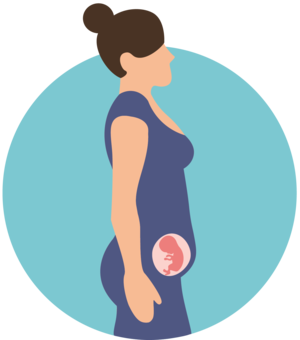Pregnancy at week 20
4-minute read
Your baby
Your baby is now very active as their muscles become more mature. You will probably be able to feel them moving around by now. They weigh about 320g and measure about 16cm, the size of a cantaloupe or rockmelon.
The baby has fingerprints, permanent teeth in the gums underneath their baby teeth and, if it’s a girl, there are already eggs in the ovaries. Cartilage throughout their body is turning into bone and the bone marrow is starting to make blood cells.
The baby’s ears haven’t finished developing yet but they can hear sounds from outside the womb. Their body is covered in a white substance called vernix, which protects their skin from the amniotic fluid.
Your baby at 20 weeks
| Length: | 16cm |
| Weight: | 320g |

Your body
Congratulations, you are now half-way through your pregnancy. The top of your uterus, called the fundus, is usually now roughly level with your belly button. Your doctor or midwife can feel it when they press on your tummy and will regularly check the size of your uterus.
As your uterus takes up more room, there is less space for your other organs, including your heart and lungs. This might make you feel breathless from time to time, especially when you lie on your back. Also, you might find your back and hips are aching. Putting a pillow between your legs when you lie on your side will help.
You might also notice that you are quite clumsy now. Many women report ‘baby brain’ when they are pregnant – their memory and brain function is less effective than before they were pregnant. This tends to get worse into the third trimester, but it’s nothing to worry about and is completely normal.
Things to remember
You might have trouble fitting into your normal clothes at this point. But, you don’t have to spend a lot of money on maternity clothes – look through your wardrobe for loose fitting tops, or borrow from your partner or friends. You can buy an ‘expander’ that makes your normal pants and skirts larger so you can keep wearing them through your pregnancy.
You don’t have to wear a special bra while you’re pregnant, though underwire bras are not recommended during pregnancy. Many women find a maternity bra more comfortable. Bras designed for pregnancy can also be used while you’re breastfeeding. It’s a good idea to have a maternity bra professionally fitted, if you haven’t done so already.
If you haven’t yet had your second trimester ultrasound (fetal anomaly or morphology scan), then now is the time to have it. You should also talk to your doctor or midwife about any other tests you need during your pregnancy.
Read next

Your pregnancy at 21 weeks
Learn about your pregnancy journey and what is happening to you and your baby.

Speak to a maternal child health nurse
Call Pregnancy, Birth and Baby to speak to a maternal child health nurse on 1800 882 436 or video call. Available 7am to midnight (AET), 7 days a week.
Learn more here about the development and quality assurance of healthdirect content.
Last reviewed: April 2022





